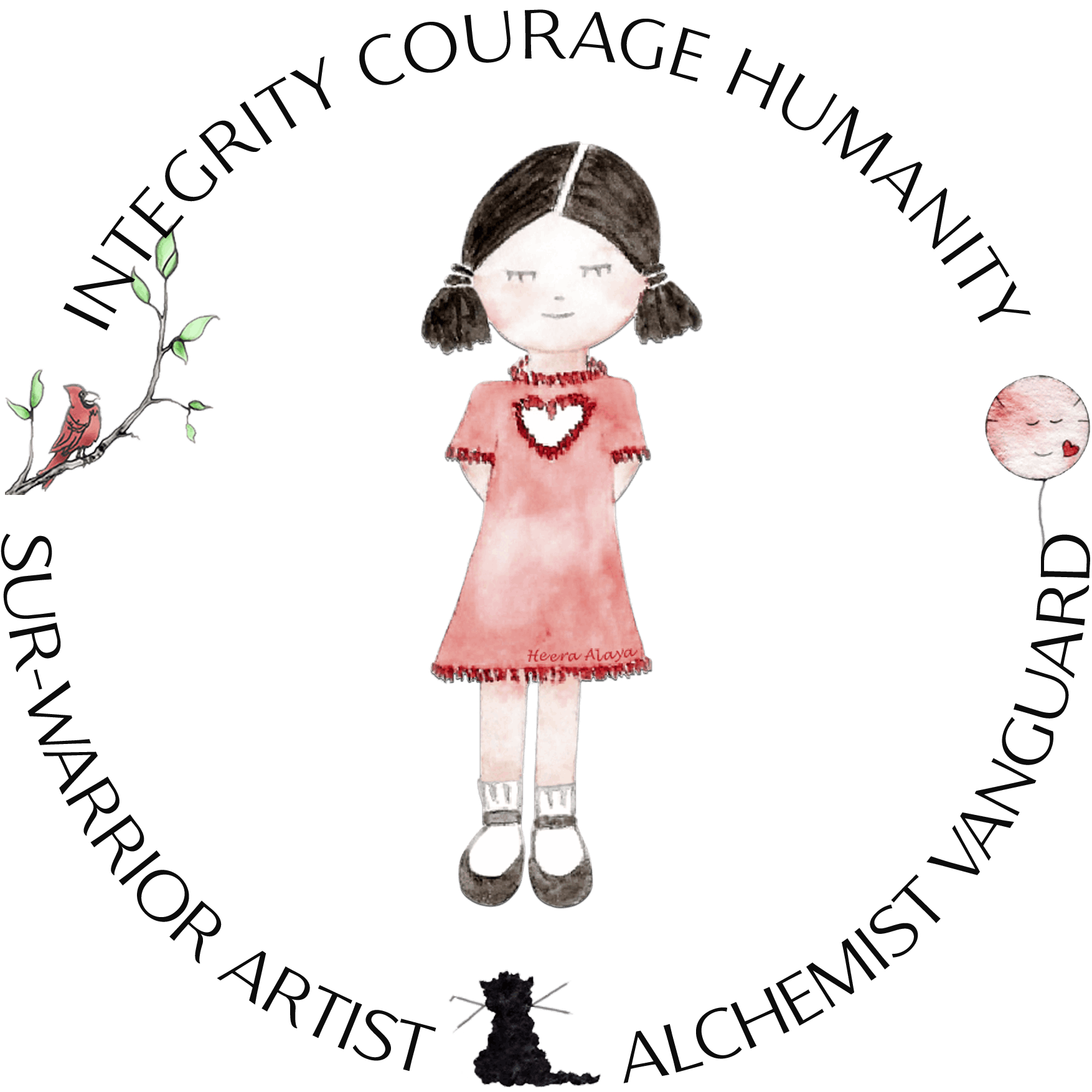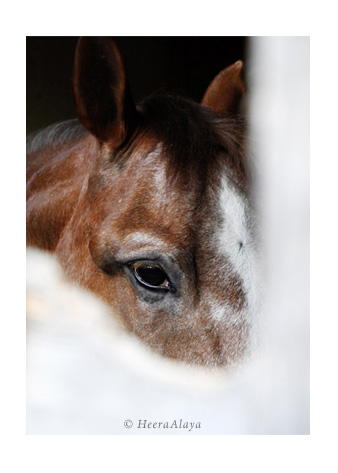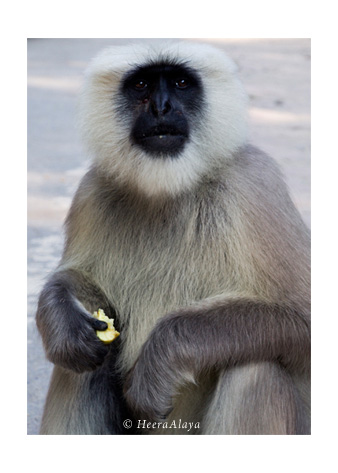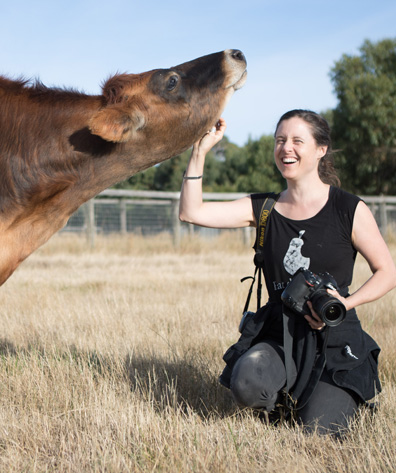
“Cows are constantly re-impregnated,
and their babies are taken away for slaughter
so we can drink the milk.”
JO-ANNE MCARTHUR
Photographer for Animals, CA
January 1st, 2021
OPEN WINDOWS | In Conversation
Jo-Anne McArthur is a photographer for animals and an animal rights activist. Through her haunting photographs of animals, Ms McArthur makes visible the exploitation and cruelty hidden from our sight. Individuals worldwide are guided out of denial and ignorance and led towards education to empathise, respect and treat animals as sentient beings. Ms McArthur’s accolades include the Wildlife Photographer of the Year, the Alfred Fried Peace Award, Australia and the Wildlife Photographer of the Year, Italy. Jo-Anne McArthur’s published books include We Animals, Captive and Hidden.
Heera Alaya: Thank you for being a highly empathetic individual and genuinely caring for animals. Though I am not living your life, I can identify with you when you say witnessing cruelty affects you because observing pain and trauma becomes part of my DNA.
Jo-Anne McArthur: I spent 18 or 19 days (in the near past) photographing day and night in Israel and Turkey, focusing on animals’ export-import situations through live (export) transport, which left me feeling emotionally exhausted and unhappy. I was photographing The Bahijah, an Australian ship in Israel, coming in after almost two weeks at sea, transporting between 20 and 30 thousand animals, primarily cows and some sheep, on board. We saw three different boats at three other ports docked in Israel. The animals go from sea to trucks. Animals are crowded into those trucks, transporting them straight to slaughter. I had to photograph the same in Turkey.
I am honoured that I got to do this work and appreciate having these opportunities to do this work. But the emotional toll you are talking about is very heavy. After such trips, I am so grateful to be home and have the small pleasures of life, working quietly at my kitchen table and having tea with soymilk.
What do you aim to tell with the animal images you capture?
My job [photographing animals] is to create connections with these animals beautifully and interestingly. The very point of what I do is to make eye contact with these animals. And, of course, they look at me and other people with their eyes full of questions: “What’s next? Where am I going? What are you doing to me?”
My images try to capture what we put these animals through. If we think about animals—if we think about them at all—we might think it’s a pig on a farm or a beautiful-looking farm. Animals suffer so much, and a big part of their pain is how they are transported. We don’t know, and we don’t consider looking into those transport trucks; I have been looking into those trucks to see how animals are suffering and to show animals reality to the world.

You said, “I photograph the predicaments animals are in because of humans.” How does photography serve your purpose of showing animals as sentient beings?
People refer to me as an animal or a wildlife photographer; I am certainly not that. I am a photographer for animals. I take photographs to help animals, which is different from what many other people do.
Mostly, I don’t do pleasant portraits because the world is saturated with those images. We know animals are beautiful—their colours, feathers, fur, and eyes are all beautiful, but those images don’t serve animals very much. So, my job is different in photographing the construct in which we keep these animals. In most of my images, you will see the background—the barns, the fences, the slaughterhouse, the caging and the filth, all of those things that create these environments in which we keep and kill animals.
What makes you sensitive to animal suffering?
I wish I could give you one concrete answer for others to tap into and emulate, as that’s what we are trying to do as empathetic animal advocates.
My earliest recollection is that my parents didn’t discourage me from demonstrating empathy. Our neighbours kept a dog outdoors throughout the year, even in winter. This dog would bark and cry. I would go to the neighbour’s house and ask if I could play with the dog and take it for a walk. Picture a little girl with a huge Shepard-Rottweiler mix. I kept going back because my parents allowed me to express my empathy. And I suspect empathy is stamped out of a lot of kids, thought of as unimportant.
My parents’ encouragement might be one piece of the puzzle, but living in the countryside with my mother is what led me on the path to working on behalf of animals and veganism. My mother had laying hens that would wander around the property, were friends with the dogs and the cats, and wanted to come inside just like the dogs. I saw animals with different personalities, and I became very uneasy that these animals were treated so differently by society.
It took me a while to transition, as chicken was my favourite meal; I would eat it five times a week. And I thought by not eating meat, I was going to suffer.
Through the process of turning vegan, I learned that I didn’t feel deprived; instead, I feel intellectually, emotionally, and spiritually aligned with my beliefs.
In the documentary The Ghosts in Our Machine, you say: “Leaving is always the hardest thing. Leaving is the reason I am haunted. I am closing the door as I leave this factory farm or the slaughterhouse. I am closing the door and leaving them behind.” What does animal activism cost you on a personal level?
The emotional cost [of being an animal rights activist and educator] is undefinable. A great deal of sadness lives in a black hole inside of me—stories of individuals, traumatic sights and suffering; I don’t know what to do with that, and I can’t put it into words. Therapy helps. What also helps me is reading Buddhist texts on mindfulness, meditation, finding happiness, and not taking part in one’s dramas. Dramas can play out repeatedly in my mind, and I can focus on getting work done instead of existing in all the sadness.

How would you describe your mental state when you are functioning as both a human being who genuinely empathises with animals as well as an animal photographer capturing stories of animal cruelty?
My empathy is at the forefront, but with a strong emotional barrier between what I see right in front of me and what I photograph. I often have just moments to shoot; for instance, when photographing a moving truck, the truck might stop for 10 seconds. Moreover, I work hard to get things in place to travel around the world, and when I am there, I have to do the best possible job in front of me. I am focused on the photo aspect–composition and lightning—because I haven’t done the job if I cannot achieve important and poignant images.
Capturing the truth is definitely at the forefront.
What are the roadblocks and inherent dangers connected to undercover infiltrations?
Undercover infiltrations come with dangers for sure because sometimes I am trespassing. I would say that almost all of my investigative friends have either been jailed or beaten; I have figured that it’s a matter of time before the same happens to me. The dangers of physical violence, significant legal fees and jail time are the price that many of us have to pay for doing what we do [exposing animal cruelty]. There is also the physical danger; for example, I was trying to get images of animals in a transporting truck, and the truck swerved. Moreover, these trucks are massive vehicles that take off quickly and can crush you instantly.
Is there a difference between animal equality and animal rights?
I can say that there is no respect for animals on earth—animals are exploited for entertainment, food and wildlife. We hunt animals, and we encroach on their territories. We have hierarchies, and we place humans at the top, translating into animal suffering and death.
All we call rights and liberations is about learning that animals deserve a place just like humans. Animals have inherent rights. We have a long way to go before we understand that [inherent animal rights], and once we realise that, I hope we will give animals the space and respect they need, which means no violence and no suffering.
Can you explain cognitive dissonance in the context of animal cruelty?
Most people, if asked, “Do you like animals?” will claim to love animals, but this love does not translate to respect or empathy for animals or to taking action to ensure that the other animals whom “we love” have a decent life. And so, we do all sorts of questionable things to be near the “animals we love.” An example of this behaviour is our actions towards dolphins with smiling faces (whom many of us love); we enslave them to swim in the dolphin industry or aquariums—because we feel we have the right to see or swim with them. So, we take our admiration or love and entirely bastardise it for our benefit. And all the while, we are incarcerating animals.
I visited a bullfighting school many years ago with a group called Animal Equality. There were a lot of young boys training to be bullfighters, and I asked one of them: “Why do you want to be a bullfighter?” And he replied: “Because I love bulls.”
This attitude shows cognitive dissonance instilled at a young age—a child is taught that he can love a bull, but he can also horribly slaughter a bull.
Would it be accurate to state that the inherent nature of animal cruelty is designed for profit and that our conditioning feeds right into that destructive cycle of exploitation?
You said it [animal cruelty designed for profit] better than I could.
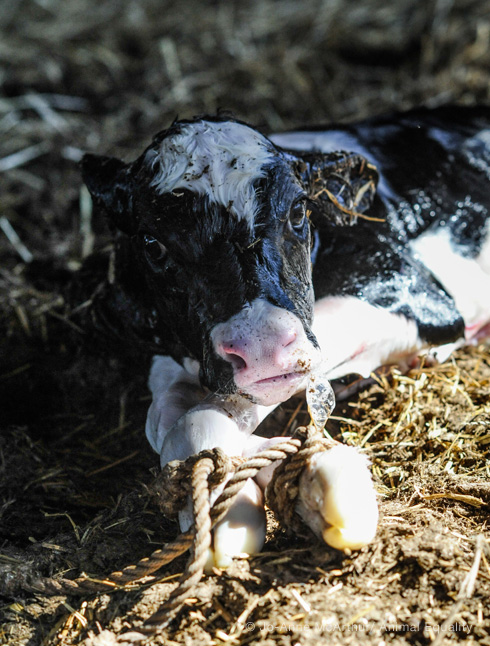

Do children become desensitised when exposed to various forms of animal confinement and degrading, like dolphins in small enclosures, chimpanzees in zoos, elephants in circuses and donkeys used as entertainment?
Yes. Children believe that degrading and confinement of animals is the norm. Not every child is insensitive; as a child, I would go to a zoo and feel bad for the animals. As you know, I went to zoos for my book Captive and spent hundreds of hours. I heard children commenting on being sad, watching animals go back and forth in their enclosures; children also observed animals looking sad. But when we see animals on display, we are not going to think critically or be clear, to use our minds about these things—we are going there only because we want to be entertained. And so, when people ask the hard questions—what makes the inevitable observations questionable, the parents will say: “Yeah, but let’s keep walking; let’s go get some ice cream.”
Whether at zoos, circuses, or rodeos, we may find some objection to what we see, but because everyone participates, we figure it must be okay. And we have seen that with genocide, and we have different examples of slavery—when an act is regarded as the norm, it continues. That is why we need the protestors; we need people speaking out because they will get the ball rolling and be the change, and this is something we see right now. It’s an exciting time in history to join the animal rights movement. So much is changing from science to lab-grown meats to veganism to laws.
Do children have the power to say no to participating in animal cruelty (as food, entertainment and amusement)?
Even though many children may want to eat fewer or no animals, their parents are often not open to listening to them and insist their children eat animals. Children don’t influence their parents, so, unfortunately, it’s usually only later in life that children choose not to eat animals, and by that point, they might have changed their minds.
Kids are genuinely empathetic, and when you tell them that the bacon you eat is a pig, it affects them. But that’s not usually the information we give children.
How is your We Animals Humane Education Program tailored to educate children on animals as feeling beings, and what role does photography play in children’s understanding of animals?
All of our talks are age-appropriate—we can get into the harsh realities of factory farming for the older groups while ensuring we do not traumatise younger students through the imagery. Sometimes, the conversations introduce children to individual animals: this chicken named Jolene or this pig named Juliet was rescued from factory farming. We educate children on factory farming, focusing on the individuality and quirks of the animal.
We want children to realise that these animals [chickens and pigs] are just like dogs and cats and that we know and love that calves have complex emotions.
Is there a common thread in the nature of questions children ask you?
During my talks with young children, they asked: “What can I do? I am just a kid.” So, I will address this concern: we all can make the world a better place for animals. Children don’t have the finances, and neither do they cook in the house. So I offer children some choices: “When your family goes on vacation, you can choose not to take part in entertainment that involves animals, and you can ask your parents to visit a sanctuary instead of a zoo.” I also educate children on trying Meatless Mondays and speaking to friends about being kind to all animals. These tools for children make them feel empowered.
These conversations aim to widen our circle of compassion to include all animals. I want kids to feel empowered to act kindly and speak up. I also give children examples of different skills they can use in various jobs they will come to pursue, from neuroscientists to lawyers, to make the world a better place for a lot of animals.


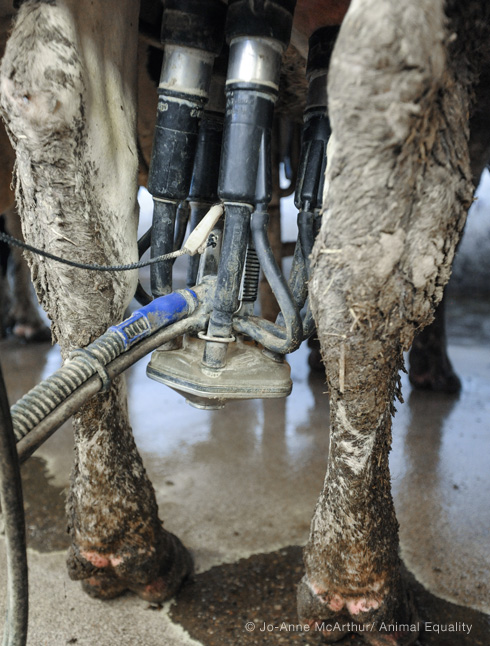
What is the reality of cows depicted as happy on product packaging? And what is veal farming?
I am glad you asked me this [dairy and veal farming] because I am very passionate about cows, and to shed light on the dairy industry is crucial.
We don’t realise that it’s incorrect when we say: “I am a vegetarian, and I am not killing any animals.” A lot of people who consume dairy will be appalled entirely by veal farming, where calves are taken away from their mothers, put in crates, and killed.
The fact is that the veal industry exists because the dairy industry exists.
When people reduce meat and animal consumption, they often start with bigger animals like cattle, pigs, and then maybe chicken. But if people change their animal consumption to reduce animal suffering, they would start with the animals that suffer the most—laying hens and dairy cows.
Most people usually assume that cows continually lactate; people don’t realise that cows are constantly re-impregnated, and their babies are taken away for slaughter so we can drink the milk. I want people to understand cows’ suffering, especially female animals, who are kept in cramped conditions and eventually killed. Cows have a lifespan of 30 years, but dairy cows are killed by the time they are around four years old; it’s awful.
Considering water consumption and carbon emissions, how destructive is animal agriculture’s footprint? Can a supporter of animal agriculture be a friend of the environment?
It is a contradiction to eat factory-farmed animals and be an environmentalist. Animal agriculture has been left out of the environmental movement, which is an absolute shame; I think this has happened because we are addicted to eating animals. Factory farming causes much destruction, from the methane cows produce to land damage and deforestation, affecting climate change. It’s a significant oversight. I hope it will change and continue to improve.
Which fields of research and vivisection typically use animals, and what types of animals?
In the name of research—from finding cures for cancer to testing cosmetics—we sacrifice animals. Research and vivisection are conducted on a broad range of animals, from mice to chickens to chimpanzees (who are being phased out). Research is still performed on animals from monkeys to rabbits to fish and fish embryos; they run the gamut of research.
What are some practices involved in animal testing?
Stress testing—to study flight or fight response—is a big part of animal testing. Also, during emotional and behavioural testing, animals are kept away from their family and community members in small cages. The “enrichment” provided to animals is substandard and in an entirely unnatural environment; animals have no quality of life, whether mice or monkeys.
Does cruelty—from captivity and isolation—disfigure animals emotionally and psychologically?
We can’t ask the animals what they feel, but we can see and understand the visible signs of the cruelty animals are subjected to—swaying back and forth, self-injury, and self-mutilation.
We do a great deal of harm to animals because we don’t share a common language. If pigs could speak our language, and monkeys or mice could tell us how they feel, we would not easily disregard their interests.

Your photographs of animals have the potential to profoundly impact humans. Why does mainstream media hesitate to publish such images?
Mainstream media might perceive that they would lose their audience credibility because only a few people think it’s an important issue. And they [media] could also lose funding—it’s probably hard to put out an anti-dairy story when you are being funded in parts by the dairy industry. There are many barriers, but that is changing. The Guardian, for example, has a vast series called “Animal Farmed,” which looks at welfare and sentient problems. It feels good to see that change in the media industry.
How do you deal with rejection, especially knowing you are contributing works of significance to society?
Rejection used to be incredibly frustrating; now, I am not only used to it, but I also deal with rejection by finding other homes for my work. My response to not being published is to create the We Animals Archive, which has over 10,000 photographs and videos available for free to anyone helping animals.
Over a year ago, we put up the archive and have had over a thousand requests. These images of animals are used from as far away as South Sudan to New Zealand. We know our endeavour is highly successful as we get requests for photos every day, and they are quickly utilised by animal advocates of all kinds worldwide.
How did you arrive at your books Captive and We Animals?
My book, Captive, was timely—the ethics of animals kept in captivity is in focus right now, and I wanted to contribute to the conversation. During the same time, I had been commissioned by the Born Free Foundation to visit a cross-section of zoos across Europe. So, I had adequate material to create Captive.
We Animals is a visual book with lots of photographs from countries all over the world. I saw that no one had created a book of this nature—looking at the individual in the system we have designed—and created a book that raises topics from research to farming.
How do you get yourself to part with intimate moments between the animals and you?
These poignant moments—where the animal is engaging with me, thus looking into my eyes, lens, and audience—are precisely what I strive to capture to get them out into the world.

Do specific human qualities foster respect and kindness towards all animal beings?
Most of us are born with these finer qualities [respect and kindness], but they are often not cultivated. And though we can lead kind and empathetic lives, it is not a priority—people are busy, hungry, or don’t have money. When poverty, stress and violence dominate, we over-concentrate on making ends meet and getting through our day-to-day life, whether that’s in Toronto or rural Uganda.
Who and what contributes to your continuing evolution?
I continue [being a photographer for animals] because I see how my work affects other people and how they change every day. My team and I have to reply to overwhelming requests for images, mentorships, and interviews as people are now interested in learning about animals as sentient beings. And it’s so incredibly important to me that it keeps me going forward, knowing there is a growing audience. My work has influence, and now is certainly not the time to stop.
Has turning vegan influenced the way you interact with the world?
Being a vegan is kinder to others but also kinder to myself. I chose to be a vegan as my way of living happily in the world and interacting kindly. And knowing what I know, I would have felt like a hypocrite had I continued to eat animals.
I feel much more peaceful by not eating animals; I am living in alignment with my philosophy of kindness in the world.
Learn more about JoAnne McArthur.
